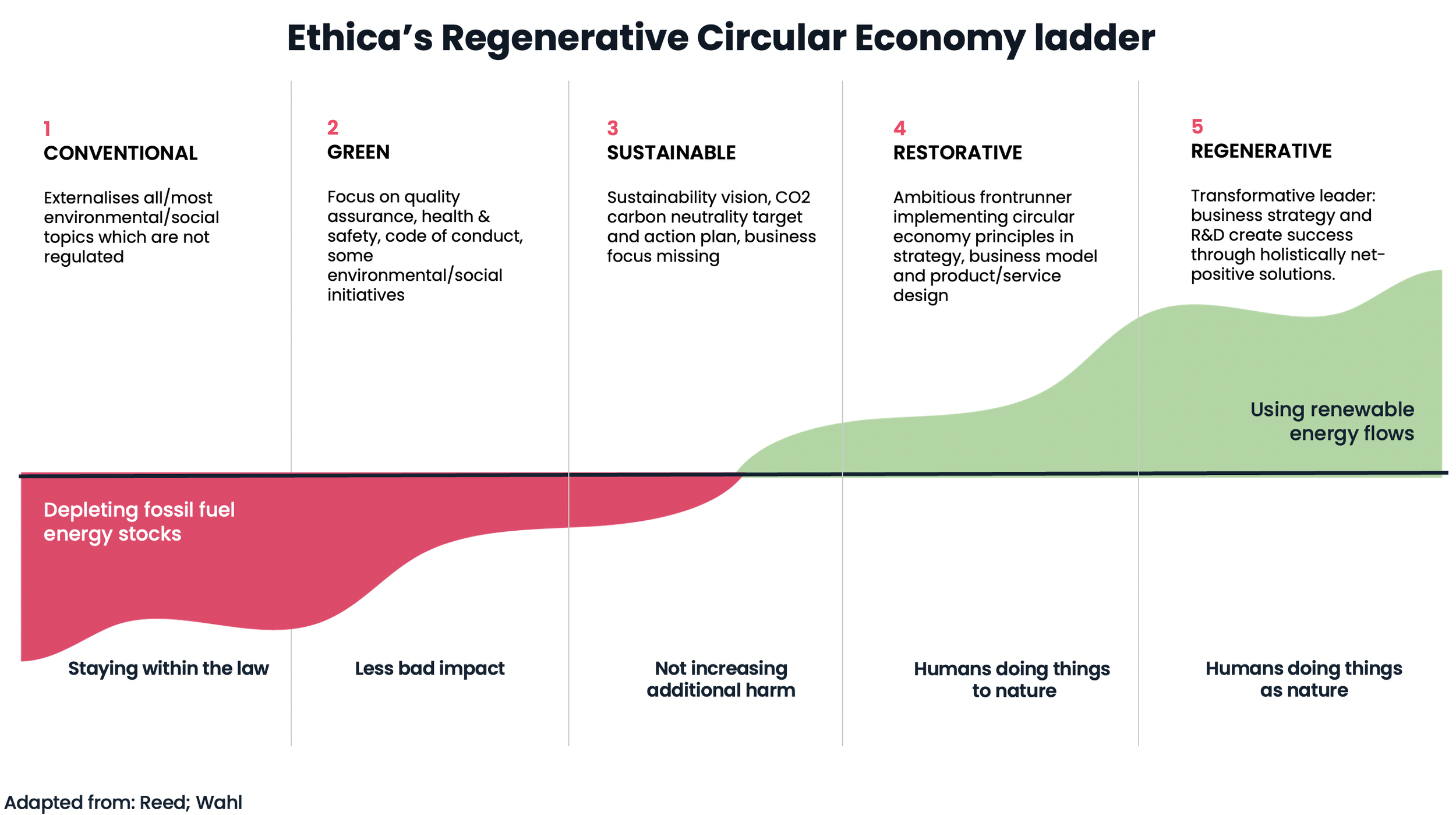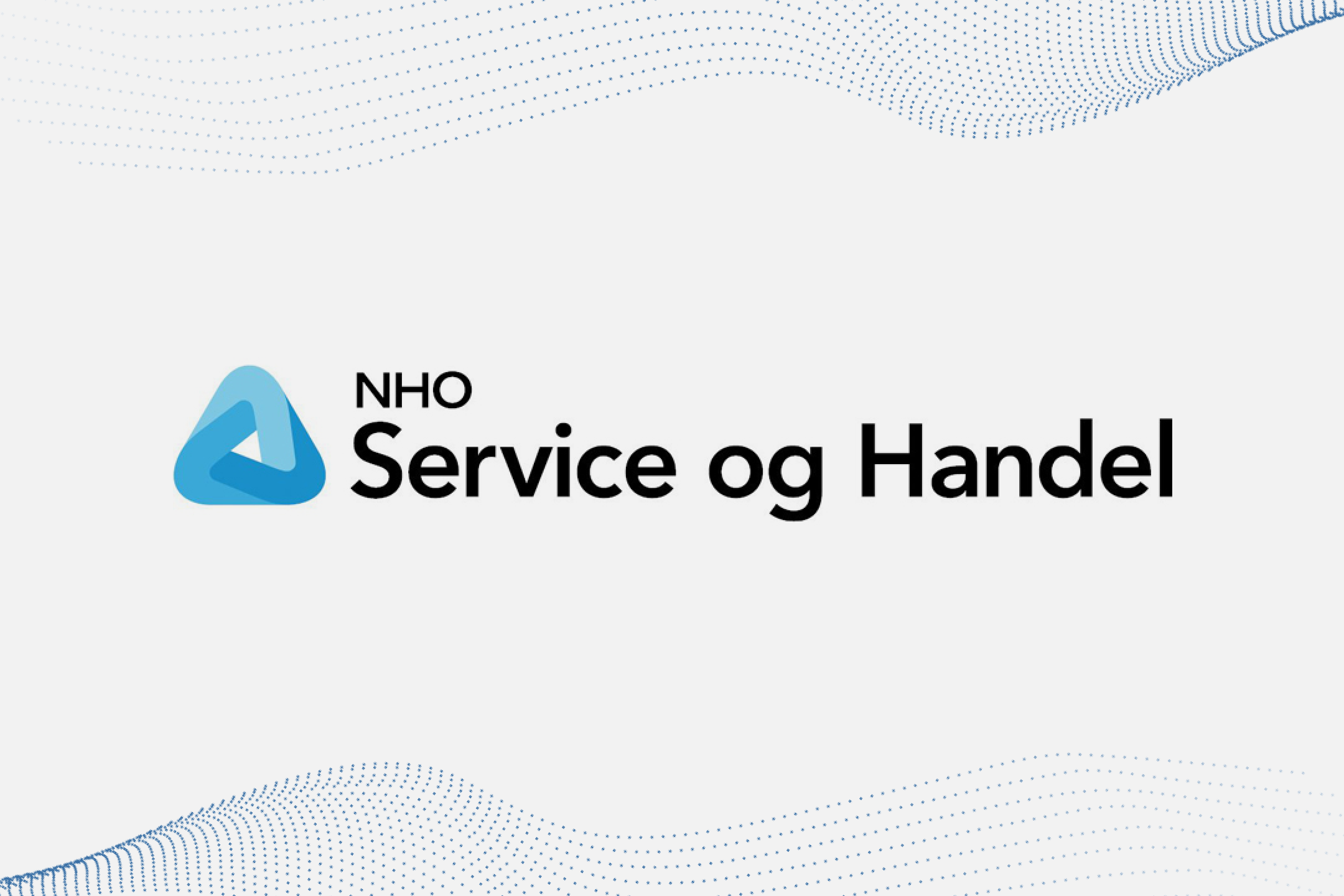What does regenerative circular economy mean in business?
In this blog, Anne Raudaskoski from Ethica reflects on developments in the regenerative circular economy and how companies can, with examples from frontrunners, take the first steps towards becoming regenerative. Where is your company or organisation on the regenerative circular economy ladder?
“This is no time for ambiguity. Business operations are either working towards restoring our world socially and ecologically, or are depleting it.”
This is stated in a report released in 2022 by the Forum for the Future and the WBCSD. Similarly, the EU Circular Economy Action Plan (2020) states that the EU should transition to a regenerative growth model, where the planet is given more than is taken from it.
So, we have come a long way from corporate responsibility to sustainability, then to the circular economy, and now, over the past three years, the term 'regenerative circular economy' has grown in importance from the backroom towards the limelight. However, more important than terminology is, of course, where companies set the bar for goals and concrete action, so now is the time to examine in more detail what a regenerative circular economy means and why it is extremely important to get it to the executive agenda. Pioneer examples are constantly increasing — I will come back to those later.
Background to the term ‘regenerative’
Like few things in this world, ‘regenerative’ has not emerged out of nothingness but has been part of various frameworks for a long time. For example, the Cradle-to-Cradle (C2C) approach developed since the 1990s suggests that companies should move from simply slowing down problems and “less bad” solutions towards the role of problem solver and 100% good business (the difference is also described by the terms eco-efficiency versus eco-effectiveness). The developers of the C2C framework, M. Braungart and W. McDonough, have aptly asked whether zero is really the best that people can achieve and whether reaching for zero is not a rather depressing vision. The current strong focus on achieving carbon neutrality reflects this aim for zero, which is, of course, good and necessary, but inadequate and overlooks many opportunities for a significantly broader positive impact (and, in fact also the necessity of carbon negativity).
Another good conceptual anchor for the term 'regenerative' is, for example, Kate Raworth's Doughnut Economics model developed in 2012, which envisions how we as a society and companies can thrive within the limits of one planet's carrying capacity. The doughnut represents parameters for a regenerative economy, which is not only ecologically sustainable — the ceiling of the doughnut model is the planet's nine boundaries — but also socially just and safe — the “floor” of the doughnut is formed by various dimensions of social perspectives (the right to water, food, education, equality, etc.).
The term ‘regenerative agriculture’ has perhaps been used the longest, and it also gives a very concrete form to the term ‘regenerative.’ In an agricultural context, the goal is to improve soil fertility. Almost without exception, current intensive production methods, which use chemical fertilisers and pesticides, have depleted soil fertility, and the regenerative approach aims to reverse this trend.
Here’s what’s happening on a larger scale at an accelerating pace; we are gradually depleting Earth’s resources, which are not only our habitat but also the foundation of business: every single company is dependent on nature, its raw materials, resources, and various ecosystem services (for example, bees are needed to pollinate coffee trees so that we can enjoy coffee).
Bocken & Short, 2021
From the circular economy to the regenerative economy
Although the circular economy model is necessary, it is worth asking whether keeping high-value materials in circulation and saving natural resources is a sufficient goal, or whether the approach should be even more systemic in understanding the interdependencies and the need for teamwork between social, economic, and environmental perspectives? And the answer is that a broader perspective is actually necessary for companies to move to a new level.
The accompanying graph (Bocken & Short, 2021) illustrates the change in the new target state excellently, and it is noteworthy that there are actually three more ambitious steps to be taken after the word ‘circular economy’.
Forum for the Future defines the term as follows: “a regenerative and fair approach means 1) a desire to support nature’s ability to heal and regenerate 2) an understanding that people are fundamentally part of nature 3) respecting everyone’s universal right and potential to flourish.”
Hahn & Tampe (2021) define regenerative business as follows: “Companies that thrive through socio-ecological well-being, improving them in an interactive development process.”
In Ethica’s Circular Business Guide (June 2021 in Finnish), we defined regenerative growth as follows: “Economic and well-being growth that occurs when activities focus on continuous renewal of resources instead of consumption. This means using materials and designing products in a way that they fit into the circular economy of human-made material flows in a way that supports natural ecosystems. Accordingly, the production and use of goods have an ecological, social, and economic capital-increasing effect. For companies, this is most and foremost about innovation and R&D activities”.
Wow, quite a bit of word art, the reader may say! For the management team, these may still be a long leap to set strategic goals, let alone think about practical planning solutions. Or maybe not.
Who is already implementing business according to the circular economy principles?
A few examples of pioneers are probably necessary. Let’s start with my own long-time favourites: the carpet company Interface radically transformed its business already in 1994 with a full turnaround of founder-CEO Ray Anderson’s thinking. Biomimicry (i.e., learning from nature’s design solutions) was adopted as the basis for design solutions, and the entire staff was trained on the subject, while the business model was shifted from selling products to selling services. The list of Interface’s innovations could go on endlessly, but it suffices here to say that the original vision was Mission Zero by 2020, but based on transformative thinking, a new Climate Take Back programme was launched already in 2016.
Another fantastic example is the Swedish sportswear brand Houdini, which is also undergoing a similar transformation journey. Their purpose and vision, freely translated, are as follows: “We want to inspire and enable humanity to reconnect with nature, live a healthier and happier life as part of nature, develop as individuals, and build a thriving society on a thriving planet for us and future generations.”
In addition, it is worth checking out, for example, the Human Conscious Design® approach of Tarkett, a floor designer and manufacturer; the missions and fantastic innovations of the Finnish companies Origin by Ocean and Granulous, and the regenerative goals of Stora Enso. Also, Guyaki, a maker of yerba mate tea, has a great vision and lots of inspiring “transformative” concreteness to explore.
Starting with 5 steps
Take a moment for reading, reflection, and discussions. In other words, create mental space for a new way of thinking before you start thinking about concrete business solutions.
Examine your current business operations from a system level, i.e., from a bird’s-eye view: which functions are already in line with the circular economy, perhaps even transformative, and where are you clearly falling short. Are there “black boxes” in the value chain, i.e., points where there is actually no detailed information?
Use an “outside-in” approach: traditionally, stakeholder identification has listed employees, customers, owners, suppliers, partners, legislators, and the media, for example. Transformative circular economy businesses take a significantly broader perspective; the company is seen as part of the (planetary) (eco)system — which it affects either net positively or negatively. So stakeholder analysis will now include, depending on the operation, the water system where the factory is located, the soil from which the company's raw materials originate, or the local community whose life is affected by the company's operations. And let’s not forget future generations; today’s innovations affect their lives at least as significantly as those of the current decision-making generation.
What are the current strategy and goals, and on what basis are decisions made in the R&D process? Mirror the current model to transformative thinking; where are the most critical areas for development, and how will value be created for the customer with a new operating model
After the management team’s workshop on ‘What does transformative circular economy business mean,’ it is time to involve the entire staff; in addition to the need for training, they may already have a bunch of solutions that you can start implementing.
By NCH Managing Partner Anne Raudaskoski from Ethica Oy.














